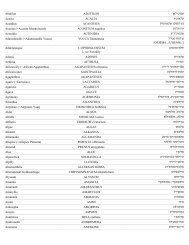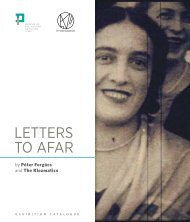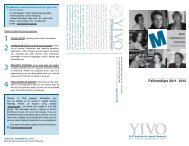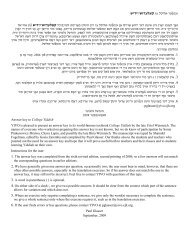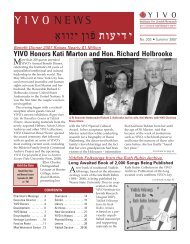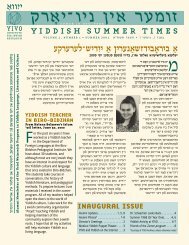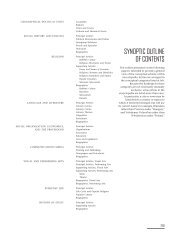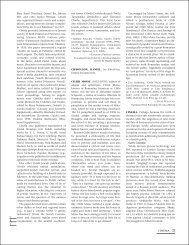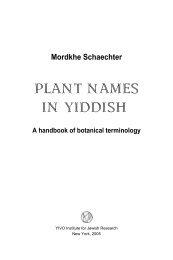Read - YIVO Institute for Jewish Research
Read - YIVO Institute for Jewish Research
Read - YIVO Institute for Jewish Research
You also want an ePaper? Increase the reach of your titles
YUMPU automatically turns print PDFs into web optimized ePapers that Google loves.
<strong>Jewish</strong> Spaces 169and humiliated by their treatment in the synagogues and study houses’, while ‘tothe simple Jew Hasidism brought genuine happiness. He became worthy.’ 13 Thevisit of the rebbe to Kamenets was a major occasion <strong>for</strong> his local followers:Once a year, the rebbe himself came to Kamenets. His arrival was preceded by three weeksof preparations, <strong>for</strong> in his wake hasidim from Brisk and all the surrounding shtetls wouldflock in. When the rebbe arrived, people stood in awe of him, as if he were the tsar himself.Hundreds of them ran to meet the carriage that brought their rebbe, and they led him intothe township with great ceremony . . . every hasid trembled be<strong>for</strong>e the rebbe and felt theawe-inspiring presence of royalty be<strong>for</strong>e him. 14Towns where a tsadik settled and established his court were trans<strong>for</strong>med. Wehave a good description by Pinhas Minkowski of the court of the tsadik DavidTwersky (1808–82) in Talnoe (Yiddish: Talne), where he was a cantor:Sprawling over a spacious meadow in the middle of the town of Talne . . . was a great court,surrounded on all sides by a fence, like a little townlet on its own, containing large and marvellouslymagnificent buildings, like little palaces: a palace <strong>for</strong> the rebbe’s wife, a palace <strong>for</strong>their only son, Mottele, a palace <strong>for</strong> their son-in-law, Meirel . . . a special palace <strong>for</strong> thecourt manager . . . and other houses specially <strong>for</strong> the Beshtian great-grandchildren andgrandchildren, who had settled there <strong>for</strong> life and lived com<strong>for</strong>tably at the expense of thecommunity and the zaddik . . . and of course there was the house of the zaddik which surpassedall others in beauty and glory.Built in this court was the rebbe’s great kloiz, which could accommodate about two thousandpeople, in addition to a large hall and a corridor, protruding from the southern wall ofthe kloiz, with a door opening into the kloiz so that the zaddik while praying alone in hishall, could also pray with the public. In the middle of the court was a large, long woodenbuilding, used as a banquet hall <strong>for</strong> meals on Sabbaths and festivals, <strong>for</strong> the zaddik and hisintimates . . . 15Pilgrimages to the tombs of tsadikim also became a feature of life in <strong>Jewish</strong>eastern Europe, usually to participate in the annual service on the anniversary ofthe death of the founding tsadik or one of his successors. One such site of venerationwas the tomb of the Besht in Medzhybizh.Religious belief remained strong in the shtetl. We have a very vivid descriptionby the Yiddish writer S. Y. Ansky of his experiences in 1881 when, as a youth of 17,he tried to bring the principles of the Haskalah to the small town of Liozno. Hesucceeded in creating a youthful circle of ‘maskilim’, which was soon discovered.Fortunately, the copy of Ḥate’ot ne’urim (Sins of Youth, a classic maskilic autobiographyby Moses Leib Lilienblum) was bound with a story by Judah LeibGordon which could not be regarded as heretical, and the threat of excommunicationwas lifted from Ansky. However, tighter control over the young people was13 14Kotik, Journey to a Nineteenth-Century Shtetl, 400, 406. Ibid. 199.15P. Minkowski, ‘From the Book of my Life’ (Heb.), Reshumot, 1 (1918), 113, quoted in Assaf, TheRegal Way, 269–70.





